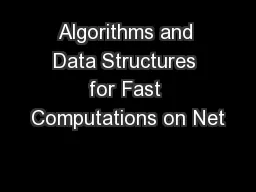

Michael T Goodrich Dept of Computer Science University of California Irvine The Need for Good Algorithms T o facilitate improved network analysis we need fast algorithms and efficient data structures ID: 490047
Download Presentation The PPT/PDF document "Algorithms and Data Structures for Fast ..." is the property of its rightful owner. Permission is granted to download and print the materials on this web site for personal, non-commercial use only, and to display it on your personal computer provided you do not modify the materials and that you retain all copyright notices contained in the materials. By downloading content from our website, you accept the terms of this agreement.
Slide1
Algorithms and Data Structures for Fast Computations on Networks
Michael T. Goodrich
Dept. of Computer
Science
University of California, IrvineSlide2
The Need for Good Algorithms
T
o
facilitate improved network analysis, we need fast algorithms and efficient data structures.Large data sizesSophisticated statistics
Data overload:
Image from http://cdn.venturebeat.com/wp-content/uploads/2009/03/28811286_e1671e30a9.jpgSlide3
Latent Space Embeddings
Hoff, P.,
Raftery
, A.E. and Handcock, M.S. (2002). Latent space approaches to social network analysis. Journal of the American Statistical Association, 97, 1090-1098.
View the vertices in a network as embedded in
d
-dimensional space.
Correlate
geometric distance with natural clusters and other network informationSlide4
Data Structures for d-Dimensional Space
Updates:
insert(p
)remove(p)changePosition(p,q)Queries:range(x1
,x2,y1,y2)nearestNeighbor(p)…More on this topic will be provided by Dave Mount.Slide5
Priority Range Trees
Data structures that are
more efficient for data exhibiting power-law distributions
Image from
http://www.macs.hw.ac.uk/~pdw/topology/Pictures/S-power.jpg M.T. Goodrich and D. Strash, “Priority Range Trees,” 21st Int. Symp. on Algorithms
and Computation (ISAAC), 2010.Slide6
Subgraph Statistics
Maintaining
subgraph
statistics dynamically can speed up ERGM computations.
D. Eppstein, E. S. Spiro, “The h-Index of a Graph and its Application to Dynamic Subgraph Statistics,” Algorithms and Data Structures Symposium, Banff, Canada, 2009. D. Eppstein, M.T. Goodrich, D. Strash, and L. Trott
, ``Extended Dynamic Subgraph Statistics Using
h
-Index
Parameterized Data
Structures
,’’ 4th
Annual International Conference on
Combinatorial Optimization
and
Applications
(COCOA)
, 2010
.Slide7
H-Index
We have designed several data structures based on the H-index.
H: maximum number such that there are at least H nodes with degree at least H.
More on this
topic will be
provided by
Lowell
Trott
(poster).
Image from
http://www.macs.hw.ac.uk/~pdw/topology/Pictures/S-power.jpgSlide8
Clique Finding
In
a social network,
where vertices represent people and edges represent relationships, a largest subset of people who all know each other, defining mutual acquaintances, is a
clique.Finding all maximal cliques is useful.Image from http://en.wikipedia.org/wiki/File:Brute_force_Clique_algorithm.svgSlide9
Fast Clique Finding
The
Bron
–Kerbosch algorithm is an algorithm for finding maximal cliques in an undirected graph.We have designed a major improvement to the Bron-Kerbosch algorithm.This improvement is implemented and interfaced with the R system.
paper yet to appear.Image from http://cnx.org/content/m11538/latest/More on this topic will be provided by Darren Strash.Slide10
Routing in Social Networks
Greedy routing is an approach that has been used since the earliest days of network analysis.
We are interested in when, where, and how it works.
Image from http://cdn.physorg.com/newman/gfx/news/hires/2009/Greedyrouting.gifSlide11
How Greedy Routing Works
A form of “
geographic
” routingHyperbolic spaceEuclidean space
D. Eppstein and M.T. Goodrich,``Succinct Greedy Geometric Routing Using Hyperbolic Geometry,’’ IEEE Transactions on Computers, to appear.M.T. Goodrich and Darren Strash, ``Succinct Greedy Geometric Routing in the Euclidean Plane,’’ 20th Int. Symp.
on Algorithms and Computation (ISAAC),
2009
, 781-
791.Slide12
Breakthrough Ideas (so far)
Viewing networks as
d
-dimensional point sets and then providing good data structures.Deriving efficiency from data distributions.Add fast
clique finding as a tool for network analysis.Studying relationships between connectivity and geography.The Geography Lesson (Portrait of Monsieur Gaudry and His Daughter), oil on canvas painting by Louis-
Léopold Boilly
, 1812,
Kimbell
Art MuseumSlide13
Future Work
Understanding and exploiting the special properties of
temporal data
.A richer set of effective tools for network analysis.Studying network phenomena, such as connectivity, communication, and influence through an algorithmic lens
.Image from http://www.guardian.co.uk/technology/blog/2008/feb/24/heresachipinyoureyeSlide14
Retroactive Data Structures
Operations have a time parameter:
insert(t,x
),
delete(t,x),
query(t,x
)
Insertions and deletions can happen in the “past” so long as they are consistent with the time line
Updates in the past propagate effects forward
Queries can be done in the present (partially retroactive) or in the past (fully retroactive)
“Back to the Future” is owned by Universal PicturesSlide15
Usefulness of Retroactivity
Developing an
algorithmic “language” with which to reason about time.
Designing structures to manage temporal datapaper yet to appear.
Image from http://chemoton.files.wordpress.com/2010/04/erdos-renyi-random-graph-evolution1.jpg
More on this topic will be provided
by Joe Simons (poster).Slide16
Category-based Routing
People often see the world in terms of clusters and categories.
Is it possible for information routing to use category counting as a notion of distance?
Yes, with a polylogarithmic number of categories More work is needed on real-world categories.ongoing work…Slide17
Network Analysis Through the Algorithmic Lens
Can a sparse random network quickly sort just by doing neighboring compare-exchanges?
Yes, if there are a lot more nearby connections than distant ones.
There is a family of random networks of O(n log n) edges, each of which sorts its elements in time O(n log n
) with high probability.paper is yet to appear.Image from http://webscripts.softpedia.com/screenshots/The-IGraph-Library_4.png